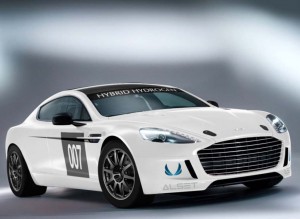Automakers often argue that there’s no better place to test out promising new technology than on the race track – which is apparently what Aston Martin has in mind for the hydrogen-powered Rapide S it will field during the 24 Hours of Nurburgring next month.
The ‘Ring is one of the world’s most challenging tracks to begin with, a place where it seems almost every serious performance-oriented vehicle is tested these days, from the new Cadillac CTS to the BMW X4. But the day-long race will clearly amp things up to the next level for Aston’s prototype.
One of Aston’s goals, according to CEO Ulrich Bez, is to complete the first “zero CO2 emission lap in mainstream racing.”
Hydrogen captured headlines in the 1990s, many envisioning it as the fuel of the future since it essentially produces no tailpipe emissions. Over the past decade, the gas has taken a technical back seat to battery power but there are signs of renewed interest as electric vehicles stall in the marketplace.
While most hydrogen research focuses on fuel-cell technology, Aston’s race car will be powered by the same twin-turbo 6.0-liter V-12 used in the conventional production car – though that internal combustion engine can be switched to operate on either gasoline or pure hydrogen.
There’ll be four tanks full of the lightweight gas, each pressurized to about 5,000 psi, two in the trunk, two more bolted in next to the driver. Even then, they’ll only carry a combined 7.7 pounds of hydrogen – roughly the equivalent of about eight gallons of gasoline.
The hydrogen-powered Rapide S will mark the beginning of centenary celebrations for Aston. “As we…look back on a century of excitement, innovation and style it’s also the perfect time to look to the future with this astonishing race car,” suggests Bez.
Next month’s race, the CEO adds, also will mark the launch of the production Aston Martin Rapide S. On the street, the AM11 V-12 is capable of launching the four-seater from 0 to 60 in 4.7 seconds, with a top speed of 190 mph.
Aston will compete for the eighth consecutive years in the ADAC Zurich Nurburgring 24 Hours race. A total of 150 cars will challenge a 15.5-mile circuit that combined both the modern Grand Prix track and the legendary Nordschleife circuit.
There’s a growing interest in using alternative propulsion on the track with planned programs including the F1-like Formula E. Most of the emphasis has been on using various battery and gas-electric hybrid technologies but some advocates believe hydrogen has some attributes that could make it particularly appealing on the track. Whether used in an internal combustion engine – like the Aston Martin Rapide S – or a fuel cell vehicle, hydrogen tanks can be refilled relatively quickly. Much faster, indeed, than batteries can be either recharged or swapped out.
Skeptics contend that hydrogen has too many drawbacks to enter the mainstream automotive market but there is renewed interest in the U.S. and abroad. Germany, in particular, has approved a multi-billion dollar project to set up a network of alternative propulsion service stations across the country that would offer both battery chargers and hydrogen pumps.
Whether Aston can further encourage interest in hydrogen power remains to be seen, but simply lasting the entire 24-hour race would be seen to some as a small victory.


Racing most definitely will reveal any issues and there are certain to be quite a few with this new tech. This tech is a far better effort than the EPA mandated 54.5 mpg CAFE.